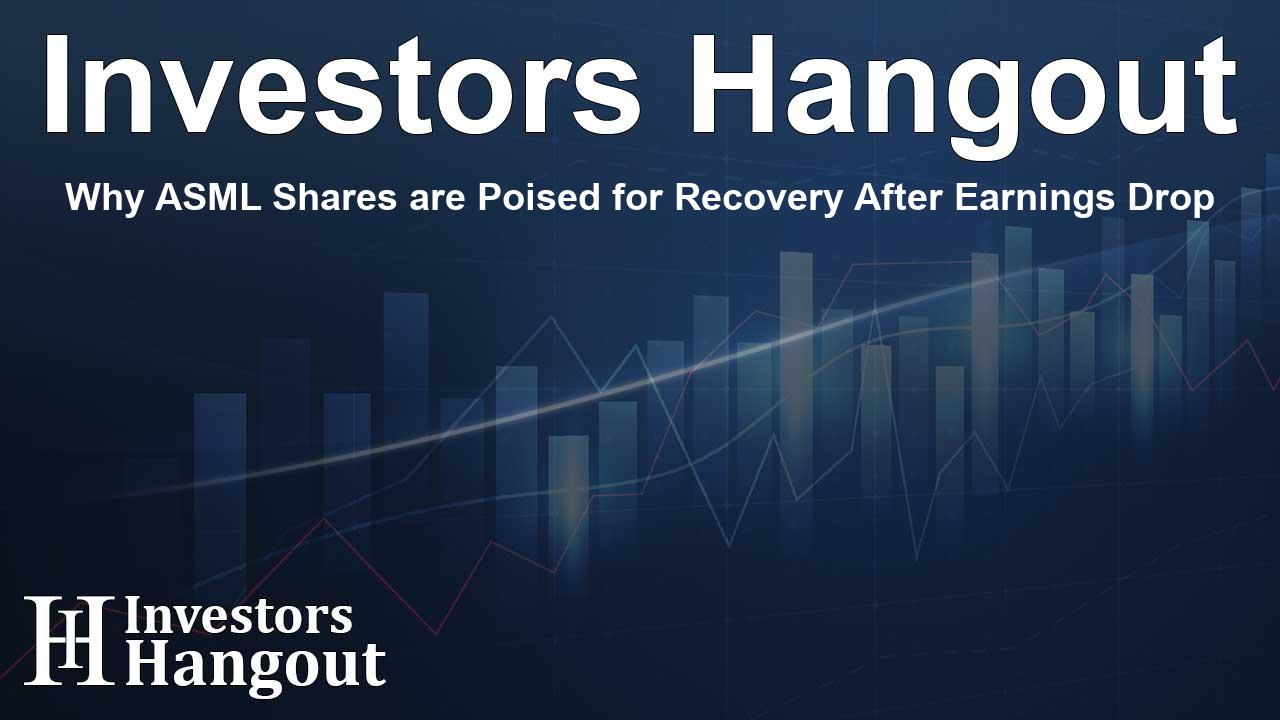Why ASML Shares are Poised for Recovery After Earnings Drop

Market Reactions to ASML's Recent Earnings Report
ASML Holdings (NASDAQ: ASML) experienced a noteworthy decline of more than 8% in pre-market trading following its latest quarterly earnings report. This unexpected drop presents a unique buying opportunity for investors, but it might not last long. Many market participants are actively seeking insights to navigate these waters.
The decline in stock price was primarily influenced by the guidance provided, especially concerning fiscal 2026, a period still two reporting cycles away. The company did not furnish negative projections but instead expressed uncertainty by withholding guidance, citing prevalent macroeconomic challenges affecting the semiconductor sector.
In the meantime, the latest quarterly report reveals that ASML's performance remains robust, with no indicators suggesting a sell-off is warranted. The positive outlook extends through 2025 and into 2026, supported by solid capital returns that can fuel stock price recovery.
Driving Factors: ASML's Q2 Earnings Results
ASML's recent Q2 earnings showcased a significant outperforming against expectations, with a reported revenue of $8.92 billion (converted from Euros), marking a 23% increase from the previous year. This result exceeded consensus estimates by a considerable margin, benefiting greatly from advancements in technology.
Despite a slight decrease in the volume of units sold compared to last year, this was balanced by favorable pricing strategies, leading to improved profit margins. ASML's CEO, Christophe Fouquet, emphasized the booming DRAM markets, crucial for AI technologies, which are reliant on advanced High Bandwidth Memory (HBM) solutions and the ongoing transition towards next-generation EUV lithography technologies.
Margin improvements are pivotal for investors to note. The company reported GAAP earnings of $6.84 per share, which were nearly $0.90 or 1,500 basis points better than the consensus forecasts, illustrating the strength of the pricing strategy.
In terms of guidance, ASML provided a more optimistic expectation for Q3 and narrowed the full-year target range, suggesting sustained momentum through the coming periods.
The balance sheet reflects strategic investments in property and proactive buybacks; however, it remains strong overall. Cash reduction and lower current asset levels have been balanced by property investments and declines in liabilities, ensuring that leverage remains minimal.
ASML's liquidity position is commendable, with long-term debt approximately 0.2 times its equity. This advantageous setup allows for continued capital returns over the long haul, including dividends that yield approximately 0.85% as of mid-July and buybacks that have decreased share counts by an average of 1.3% in Q2.
Institutional Insights and Analyst Recommendations
Market analysts and institutional investors are providing a solid outlook for ASML's stock through the latter half of the year. Although institutional ownership is under 50%, there has been a net positive buying trend, indicating institutional confidence in ASML's trajectory.
Current data demonstrates that 12 analysts maintain a Moderate Buy rating on the stock, with recent revisions indicating raised price targets. These adjustments align with forecasts predicting a potential price increase of around 12% from the pre-release closing price, and nearly 20% from the post-report opening.
The crux of the matter lies in whether ASML can maintain its stock price near key moving average clusters around the $750 mark or if there is a risk of falling below this threshold. A drop below $750 could lead to a more profound pullback, potentially bringing prices down to $650 or lower before a bottom is reached.
Investors should be aware of the risks of ASML entering a range-bound trading pattern, particularly if clarity does not emerge before early 2026. Short interest, while currently low at below 1% of the float, has been steadily increasing in recent months, which could present headwinds for the stock's performance.
Frequently Asked Questions
What was the reason for ASML's stock dip?
The dip was largely due to cautious guidance about future earnings, which has created market uncertainty.
How did ASML perform in Q2?
ASML reported Q2 revenues of $8.92 billion, a 23% increase year-over-year, surpassing analyst expectations significantly.
What is the company's outlook for 2026?
While guidance for fiscal 2026 was uncertain, analysts are optimistic about ASML's performance in the near term and believe momentum will carry through 2025.
What reflects ASML's financial health?
ASML's balance sheet indicates a net cash position, minimal long-term debt, and strong liquidity, ensuring its ability to sustain capital returns.
What do analysts recommend for ASML stock?
Many analysts maintain a Moderate Buy rating and have raised price targets, indicating a positive outlook for ASML shares in the near future.
About The Author
Contact Hannah Lewis privately here. Or send an email with ATTN: Hannah Lewis as the subject to contact@investorshangout.com.
About Investors Hangout
Investors Hangout is a leading online stock forum for financial discussion and learning, offering a wide range of free tools and resources. It draws in traders of all levels, who exchange market knowledge, investigate trading tactics, and keep an eye on industry developments in real time. Featuring financial articles, stock message boards, quotes, charts, company profiles, and live news updates. Through cooperative learning and a wealth of informational resources, it helps users from novices creating their first portfolios to experts honing their techniques. Join Investors Hangout today: https://investorshangout.com/
The content of this article is based on factual, publicly available information and does not represent legal, financial, or investment advice. Investors Hangout does not offer financial advice, and the author is not a licensed financial advisor. Consult a qualified advisor before making any financial or investment decisions based on this article. This article should not be considered advice to purchase, sell, or hold any securities or other investments. If any of the material provided here is inaccurate, please contact us for corrections.
